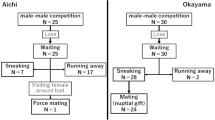Summary
-
1.
We studied the social and mating behavior of Myotis lucifugus at two hibernacula (Renfrew Mine and Tyendinaga Cave) in Ontario during the swarming and hibernation periods of 1976 and 1977.
-
2.
During July the population of bats arriving at the hibernacula consisted of adult males and nulliparous females, while in August and September subadults and post-partum females predominated.
-
3.
Inside the hibernacula bats often flew in pairs consisting of adult males following females, and transient groups of females and subadult males formed around adult males.
-
4.
Mating began in late August and had two behaviourally distinct phases. Prior to the build-up of torpid females in the hibernacula, copulations followed both paired flying associations and interactions in groups. After torpid females became common, addult males often forced copulations with torpid bats of either sex.
-
5.
Adult males showed no site fidelity or competition for females.
-
6.
The mating system is described as indiscriminate and promiscuous, and the factors determining its structure are discussed.
Similar content being viewed by others
References
Barclay, R.M.R., Fenton, M.B., Thomas, D.W.: Social behavior of the little brown bat, Myotis lucifugus. II. Vocal communication. Behav. Ecol. Sociobiol. 6, 137–146 (1979)
Barclay, R.M.R., Thomas, D.W.: Copulation call of Myotis lucifugus: A discrete, situation-specific communication signal. J. Mammal. 60, 632–634 (1979)
Bradbury, J.W.: Social organization and communication. In: Biology of bats, Vol. III. Wimsatt, W.A. (ed.), pp. 2–72. New York: Academic 1977a
Bradbury, J.W.: Lek mating behavior in the hammer-headed bat. Z. Tierpsychol. 45, 225–255 (1977b)
Brandbury, J.W., Emmons, L.H.: Social organization of some Trinidad bats. I. Emballonuridae. Z. Tierpsychol. 36, 137–183 (1974)
Bradbury, J.W., Vehrencamp, S.: Social organization and foraging in some emballonurid bats. I. Field studies. Behav. Ecol. Sociobiol. 1, 337–381 (1976)
Brosset, A.: Social organization in the African bat, Myotis boccagei. Z. Tierpsychol. 42, 50–56 (1976)
Buchler, E.R.: A chemiluminescent tag for tracking bats and other small, nocturnal animals. J. Mammal. 57, 173–176 (1976)
Carter, D.C.: Chiropteran reproduction. In: About bats. Slaughter, B.H., Walton, D.W. (eds.), pp. 233–246. Dallas: Southern Methodist University 1970
Davis, W.H., Hitchcock, H.B.: Biology and migration of the bat Myotis lucifugus, in New England. J. Mammal. 46, 296–313 (1965)
Dwyer, P.D.: Social organization in the bat Myotis adversus. Science 168, 1006–1008 (1970)
Emlen, S.T., Oring, L.W.: Ecology, sexual selection and the evolution of mating systems. Science 197, 215–223 (1977)
Fenton, M.B.: Summer activity of Myotis lucifugus (Chiroptera: Vespertilionidae) at hibernacula in Ontario and Quebec. Can. J. Zool. 47, 597–602 (1969)
Fenton, M.B.: Population studies of Myotis lucifugus (Chiroptera: Vespertilionídae) in Ontario. R. Ont. Mus. Life Sci. Contrib. 77, 1–34 (1970)
Griffin, D.R.: Notes on the life histories of New England cave bats. J. Mammal. 21, 181–187 (1940)
Gopalakrishna, A., Madhaven, A.: Survival of spermatozoa in the female genital tract of the Indian vespertilionid bat, Pipistrellus ceylonicus chrysothrix (Wroughton). Proc. Indian Acad. Sci. [B] 73, 43–49 (1971)
Gustafson, A.W., Shemesh, M.: Changes in plasma testosterone levels during the annual reproductive cycle of the hibernating bat, Myotis lucifugus, with a survey of plasma testosterone levels in adult male vertebrates. Biol. Reprod. 15, 9–24 (1976)
Guthrie, M.J.: The reproductive cycle of some cave bats. J. Mammal. 14, 199–216 (1933)
Hall, J.S., Brenner, F.J.: Summer netting of bats at a cave in Pennsylvania. J. Mammal. 49, 779–781 (1968)
Hartman, C.G.: On the survival of spermatozoa in the female genital tract of the bat. Q. Rev. Biol. 8, 185–193 (1933)
Hitchcock, H.B.: Hibernation of bats in southeastern Ontario and adjacent Quebec. Can. Field Nat. 63, 47–59 (1949)
Humphrey, S.R., Cope, J.B.: Population ecology of the little brown bat, Myotis lucifugus, in Indiana and northcentral Kentucky. Spec. Publ. Am. Soc. Mammal. 4, 1–81 (1976)
Krutzsch, P.H.: Reproduction of the canyon bat, Pipistrellus hesperus, in southwestern United States. Am. J. Anat. 143, 163–200 (1975)
Koopman, K.F.: Zoogeography of bats. In: About bats. Slaughter, B.H., Walton, D.W. (eds.), pp. 29–50. Dallas: Southern Methodist University 1970
Marler, P.: Communication in monkeys and apes. In: Primate behavior: Field studies of monkeys and apes. DeVore, I. (ed.), pp. 544–584. New York: Holt, Rinehart and Winston 1965
McCracken, G.F., Brandbury, J.W.: Paternity and genetic heterogeneity in the polygynous bat, Phyllostomus hastatus. Science 198, 303–306 (1977)
Medway, G.G.: Reproductive cycles of the flat-headed bats Tylonycteris pachypus and T. robustula (Chiroptera: Vespertilionidae), in a humid equatorial environment. Zool. J. Linn. Soc. 51, 33–61 (1972)
Myers, P.: Patterns of reproduction of four species of vespertilionid bats in Paraguay. Univ. Calif. Berkeley Publ. Zool. 107, 1–41 (1977)
Nelson, J.E.: Behaviour of Australian Pteropodidae (Megachiroptera). Anim. Behav. 13, 544–557 (1965)
Orians, G.H.: On the evolution of mating systems in birds and mammals. Am. Nat. 103, 589–603 (1969)
O'Shea, T.J.: Aspects of social organization, behavior and ecology in a Kenya population of the bat, Pipistrellus nanus (Chiroptera, Vespertilionidae). Unpublished Ph. D. thesis, Northern Arizona University (1977)
Racey, P.: Aging and assessment of reproductive status of pipistrelle bats, Pipistrellus pipistrellus. J. Zool. 173, 264–271 (1974)
Racey, P., Kleiman, D.G.: Observations on the noctule bat (Nyctalus noctula) breeding in captivity. Lynx 10, 65–77 (1969)
Sluiter, J.W., Van Heerdt, P.F.: Seasonal habits of the noctule bat (Nyctalus noctula). Arch. Neerl. Zool. 16, 423–435 (1966)
Trivers, R.L.: Parental investment and sexual selection. In: Sexual selection and the descent of man. Campbell, B. (ed.), pp. 156–179. Chicago: Aldine 1972
Tuttle, M.D.: An improved trap for bats. J. Mammal. 55, 475–477 (1974)
Walls, G.L.: The vertebrate eye and its adaptive radiation. Cranbrook Inst. Sci. Bull. 19, 1–785 (1942)
Wimsatt, W.A.: Further studies on the survival of spermatozoa in the female reproductive tract of the bat. Anat. Rec. 88, 193–204 (1944)
Author information
Authors and Affiliations
Additional information
Author to whom reprint request should be addressed
Rights and permissions
About this article
Cite this article
Thomas, D.W., Brock Fenton, M. & Barclay, R.M.R. Social behavior of the little brown bat, Myotis lucifugus . Behav Ecol Sociobiol 6, 129–136 (1979). https://doi.org/10.1007/BF00292559
Received:
Accepted:
Issue Date:
DOI: https://doi.org/10.1007/BF00292559




